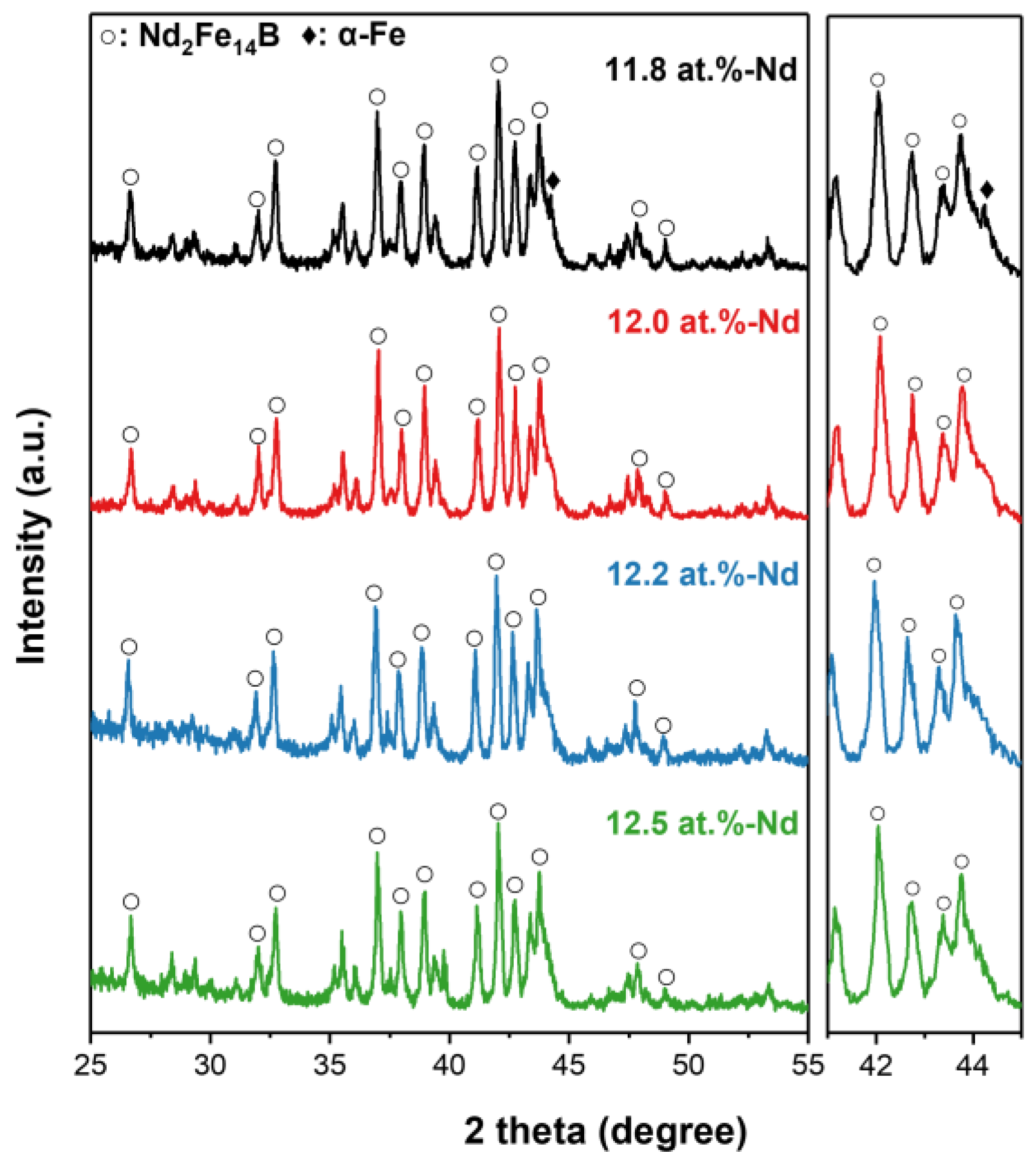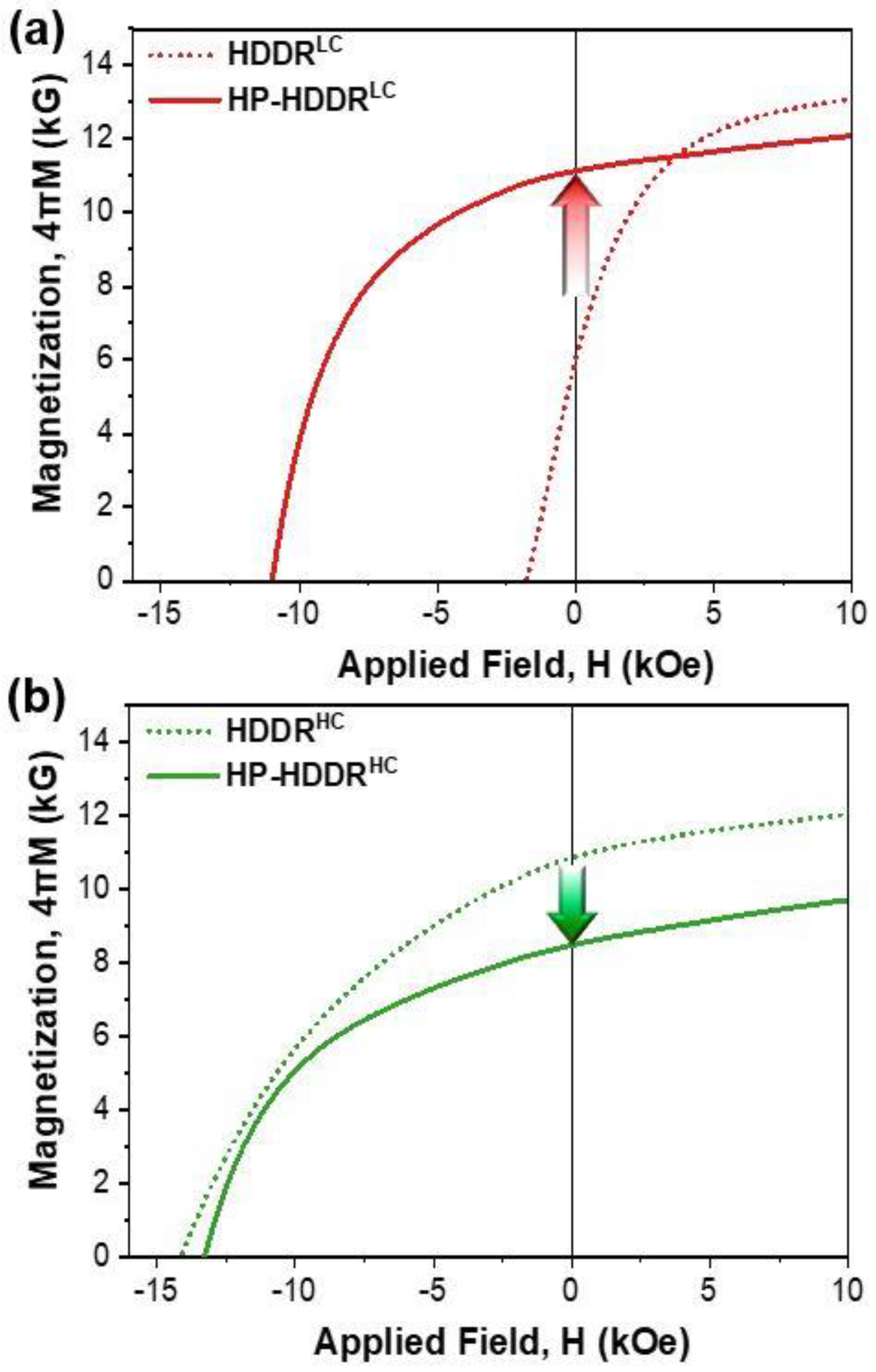Design of High-Remanence Nd-Fe-B Hot-Pressed Magnets by Manipulating Coercivity of Hydrogenation-Disproportionation-Desorption-Recombination Treated Anisotropic Precursors
Abstract
:1. Introduction
2. Materials and Methods
3. Results and Discussion
4. Conclusions
Author Contributions
Funding
Data Availability Statement
Conflicts of Interest
References
- Hirosawa, S.; Nishino, M.; Miyashita, S. Perspectives for high-performance permanent magnets: Applications, coercivity, and new materials. Adv. Nat. Sci. Nanosci Nanotechnol 2017, 8, 013002. [Google Scholar] [CrossRef]
- Sugimoto, S. Current status and recent topics of rare-earth permanent magnets. J. Phys. D Appl. Phys. 2011, 44, 064001. [Google Scholar] [CrossRef]
- Hono, K.; Sepehri-Amin, H. Strategy for high-coercivity Nd–Fe–B magnets. Scr. Mater. 2012, 67, 530–535. [Google Scholar] [CrossRef]
- Li, J.; Sepehri-Amin, H.; Sasaki, T.; Ohkubo, T.; Hono, K. Most frequently asked questions about the coercivity of Nd-Fe-B permanent magnets. Sci. Technol. Adv. Mater. 2021, 22, 386–403. [Google Scholar] [CrossRef]
- Hioki, K. High performance hot-deformed Nd-Fe-B magnets. Sci. Technol. Adv. Mater. 2021, 22, 72–84. [Google Scholar] [CrossRef]
- Liu, J.; Sepehri-Amin, H.; Ohkubo, T.; Hioki, K.; Hattori, A.; Schrefl, T.; Hono, K. Grain size dependence of coercivity of hot-deformed Nd–Fe–B anisotropic magnets. Acta Mater. 2015, 82, 336–343. [Google Scholar] [CrossRef]
- Liu, Z.; He, J.; Zhou, Q.; Huang, Y.; Jiang, Q. Development of non-rare earth grain boundary modification techniques for Nd-Fe-B permanent magnets. J. Mater. Sci. Technol. 2022, 98, 51–61. [Google Scholar] [CrossRef]
- Sepehri-Amin, H.; Hirosawa, S.; Hono, K. Advances in Nd-Fe-B based Permanent Magnets. In Handbook of Magnetic Materials; Elsevier: Amsterdam, The Netherlands, 2018; Volume 27, pp. 269–372. [Google Scholar]
- Horikawa, T.; Yamazaki, M.; Matsuura, M.; Sugimoto, S. Recent progress in the development of high-performance bonded magnets using rare earth–Fe compounds. Sci. Technol. Adv. Mater. 2021, 22, 729–747. [Google Scholar] [CrossRef]
- Takagi, K.; Akada, M.; Soda, R.; Ozaki, K. Preparation of Nd–Fe–B sintered magnets from HDDR-processed powder. J. Magn. Magn. Mater. 2015, 393, 461–466. [Google Scholar] [CrossRef]
- Gopalan, R.; Sepehri-Amin, H.; Suresh, K.; Ohkubo, T.; Hono, K.; Nishiuchi, T.; Nozawa, N.; Hirosawa, S. Anisotropic Nd–Fe–B nanocrystalline magnets processed by spark plasma sintering and in situ hot pressing of hydrogenation–decomposition–desorption–recombination powder. Scr. Mater. 2009, 61, 978–981. [Google Scholar] [CrossRef]
- Xu, X.D.; Sasaki, T.T.; Une, Y.; Kubo, H.; Ohkubo, T.; Sagawa, M.; Hono, K. Origin of the coercivity difference in Nd-Fe-B sintered magnets processed from hydrogenation-disproportionation-desorption-recombination powder and jet-milled powder. Acta Mater. 2018, 151, 293–300. [Google Scholar] [CrossRef]
- Lewis, L.H.; Zhu, Y.; Welch, D.O. Ferromagnetic grain boundary signature in die-upset RE-Fe-B magnets. Scr. Metall. Mater. 1995, 33, 1775–1780. [Google Scholar] [CrossRef]
- Soderžnik, M.; Sepehri-Amin, H.; Sasaki, T.T.; Ohkubo, T.; Takada, Y.; Sato, T.; Kaneko, Y.; Kato, A.; Schrefl, T.; Hono, K. Magnetization reversal of exchange-coupled and exchange-decoupled Nd-Fe-B magnets observed by magneto-optical Kerr effect microscopy. Acta Mater. 2017, 135, 68–76. [Google Scholar] [CrossRef]
- Yoo, J.; Cha, H.; Kim, T.; Kim, D.; Kim, Y.; Lee, J. Coercivity improvement in Nd–Cu infiltrated Nd-Fe-B hot-deformed magnets by controlling microstructure of initial HDDR powders. J. Mater. Res. Technol. JMRT 2021, 14, 340–347. [Google Scholar] [CrossRef]
- Mishra, R.K. Microstructure of hot-pressed and die-upset NdFeB magnets. J. Appl. Phys. 1987, 62, 967–971. [Google Scholar] [CrossRef]
- Lee, R.; Brewer, E.; Schaffel, N. Processing of neodymium-iron-boron melt-spun ribbons to fully dense magnets. IEEE Trans. Magn. 1985, 21, 1958–1963. [Google Scholar] [CrossRef]
- Akiya, T.; Liu, J.; Sepehri-Amin, H.; Ohkubo, T.; Hioki, K.; Hattori, A.; Hono, K. High-coercivity hot-deformed Nd–Fe–B permanent magnets processed by Nd–Cu eutectic diffusion under expansion constraint. Scr. Mater. 2014, 81, 48–51. [Google Scholar] [CrossRef]
- Wang, Z.; Zhang, J.; Wang, J.; Ju, J.; Chen, R.; Tang, X.; Yin, W.; Lee, D.; Yan, A. Coercivity improvement of hot-deformed Nd–Fe–B magnets by stress-induced Pr–Cu eutectic diffusion. Acta Mater. 2018, 156, 136–145. [Google Scholar] [CrossRef]
- Yoo, J.; Cha, H.; Jung, J.; Kim, Y.; Baek, Y.; Lee, D.; Kwon, H.; Lee, J. Effects of Initial Alloy on Microstructure and Magnetic Properties During Hot Deformation of Nd–Fe–B HDDR Powder. IEEE Trans. Magn. 2018, 54, 1–5. [Google Scholar] [CrossRef]
- Cha, H.; Yoo, J.; Jeon, K.; Baek, Y.; Kwon, H.; Lee, D.; Lee, J. Anisotropic consolidation behavior of isotropic Nd-Fe-B HDDR powders during hot-deformation. IEEE Trans. Magn 2017, 53, 1–4. [Google Scholar] [CrossRef]
- Wei, G.; Zhao, M.; Xia, X.; Li, M.; Ju, J.; Du, Y.; Tang, X.; Cao, S.; Ding, G.; Yin, W. Reduction of the mechanical anisotropy in hot-deformed Nd-Fe-B magnets by the construction of heterogeneous structure. J. Alloy. Compd. 2023, 942, 169002. [Google Scholar] [CrossRef]
- Song, T.; Wang, H.; Tang, X.; Yin, W.; Wang, Z.; Ju, J.; Chen, R.; Yan, A. The effects of Nd-rich phase distribution on deformation ability of hydrogenation-disproportionation-desorption-recombination powders and magnetic properties of the final die-upset Nd-Fe-B magnets. J. Magn. Magn. Mater. 2019, 476, 194–198. [Google Scholar] [CrossRef]
- Kirchner, A.; Grünberger, W.; Gutfleisch, O.; Neu, V.; Müller, K.H.; Schultz, L. A comparison of the magnetic properties and deformation behaviour of Nd-Fe-B magnets made from melt-spun, mechanically alloyed and HDDR powders. J. Phys. D Appl. Phys. 1998, 31, 1660. [Google Scholar] [CrossRef]
- Kim, T.; Kang, M.; Lee, J.; Kwon, H.; Kim, D.S.; Yang, C. Crystallographic alignment of Fe2B and Nd2Fe14B for texture memory in hydrogenation–disproportionation–desorption–recombination-processed Nd–Fe–B powders. J. Alloy. Compd. 2018, 732, 32–42. [Google Scholar] [CrossRef]
- Güth, K.; Woodcock, T.G.; Schultz, L.; Gutfleisch, O. Comparison of local and global texture in HDDR processed Nd–Fe–B magnets. Acta Mater. 2011, 59, 2029–2034. [Google Scholar] [CrossRef]
- Cullity, B.D.; Graham, C.D. Introduction to Magnetic Materials, 2nd ed.; John Wiley & Sons: Hoboken, NJ, USA, 2011. [Google Scholar]
- Soda, R.; Takagi, K.; Ozaki, K. Numerical simulation of magnetic-aligned compaction with pulsed high magnetic field. Scr. Mater. 2016, 120, 41–44. [Google Scholar] [CrossRef]
- Li, W.F.; Ohkubo, T.; Hono, K.; Nishiuchi, T.; Hirosawa, S. Coercivity mechanism of hydrogenation disproportionation desorption recombination processed Nd–Fe–B based magnets. Appl. Phys. Lett. 2008, 93, 052505. [Google Scholar] [CrossRef]
- Cha, H.; Yu, J.; Baek, Y.; Kwon, H.; Kim, Y.; Lee, J. The Influence of Dehydrogenation Speed on the Microstructure and Magnetic Properties of Nd-Fe-B Magnets Prepared by HDDR Process. J. Magn. 2014, 19, 49–54. [Google Scholar] [CrossRef]
- Gao, S.; Bao, X.; Lu, K.; Li, J.; Gao, X. Effect of incoherent phase boundary on fracture mechanism of sintered Nd-Fe-B alloy. Intermetallics 2020, 125, 106866. [Google Scholar] [CrossRef]
- Wang, H.J.; Li, A.H.; Zhu, M.G.; Li, W. Sintered Nd–Fe–B magnets with improved impact stability. J. Magn. Magn. Mater. 2006, 307, 268–272. [Google Scholar] [CrossRef]
- Sepehri-Amin, H.; Ohkubo, T.; Nishiuchi, T.; Hirosawa, S.; Hono, K. Coercivity enhancement of hydrogenation–disproportionation–desorption–recombination processed Nd–Fe–B powders by the diffusion of Nd–Cu eutectic alloys. Scr. Mater. 2010, 63, 1124–1127. [Google Scholar] [CrossRef]
- Liu, J.; Sepehri-Amin, H.; Ohkubo, T.; Hioki, K.; Hattori, A.; Schrefl, T.; Hono, K. Effect of Nd content on the microstructure and coercivity of hot-deformed Nd–Fe–B permanent magnets. Acta Mater. 2013, 61, 5387–5399. [Google Scholar] [CrossRef]
- Tomše, T.; Samardžija, Z.; Scherf, L.; Kessler, R.; Kobe, S.; Rožman, K.Ž.; Šturm, S. A spark-plasma-sintering approach to the manufacture of anisotropic Nd-Fe-B permanent magnets. J. Magn. Magn. 2020, 502, 166504. [Google Scholar] [CrossRef]
- Nozawa, N.; Sepehri-Amin, H.; Ohkubo, T.; Hono, K.; Nishiuchi, T.; Hirosawa, S. Coercivity enhancement of HDDR-processed Nd–Fe–B permanent magnet with the rapid hot-press consolidation process. J. Magn. Magn. 2011, 323, 115–121. [Google Scholar] [CrossRef]
- Plusa, D.; Slusarek, B.; Dospial, M.; Kotlarczyk, U.; Mydlarz, T. Magnetic properties of anisotropic Nd–Fe–B resin bonded magnets. J. Alloy. Compd. 2006, 423, 81–83. [Google Scholar] [CrossRef]
- Liu, X.B.; Gandha, K.; Nlebedim, I.C.; Paranthaman, M.P. Alignment of magnetic particles in anisotropic Nd–Fe–B bonded magnets. J. Phys. D Appl. Phys. 2021, 54, 315004. [Google Scholar] [CrossRef]
- Gandha, K.; Nlebedim, I.C.; Kunc, V.; Lara-Curzio, E.; Fredette, R.; Paranthaman, M.P. Additive manufacturing of highly dense anisotropic Nd–Fe–B bonded magnets. Scr. Mater. 2020, 183, 91–95. [Google Scholar] [CrossRef]






Disclaimer/Publisher’s Note: The statements, opinions and data contained in all publications are solely those of the individual author(s) and contributor(s) and not of MDPI and/or the editor(s). MDPI and/or the editor(s) disclaim responsibility for any injury to people or property resulting from any ideas, methods, instructions or products referred to in the content. |
© 2023 by the authors. Licensee MDPI, Basel, Switzerland. This article is an open access article distributed under the terms and conditions of the Creative Commons Attribution (CC BY) license (https://creativecommons.org/licenses/by/4.0/).
Share and Cite
Yoo, J.-G.; Kim, T.-H.; Cha, H.-R.; Kim, Y.-D.; Lee, J.-G. Design of High-Remanence Nd-Fe-B Hot-Pressed Magnets by Manipulating Coercivity of Hydrogenation-Disproportionation-Desorption-Recombination Treated Anisotropic Precursors. Materials 2023, 16, 7599. https://doi.org/10.3390/ma16247599
Yoo J-G, Kim T-H, Cha H-R, Kim Y-D, Lee J-G. Design of High-Remanence Nd-Fe-B Hot-Pressed Magnets by Manipulating Coercivity of Hydrogenation-Disproportionation-Desorption-Recombination Treated Anisotropic Precursors. Materials. 2023; 16(24):7599. https://doi.org/10.3390/ma16247599
Chicago/Turabian StyleYoo, Jae-Gyeong, Tae-Hoon Kim, Hee-Ryoung Cha, Yang-Do Kim, and Jung-Goo Lee. 2023. "Design of High-Remanence Nd-Fe-B Hot-Pressed Magnets by Manipulating Coercivity of Hydrogenation-Disproportionation-Desorption-Recombination Treated Anisotropic Precursors" Materials 16, no. 24: 7599. https://doi.org/10.3390/ma16247599





